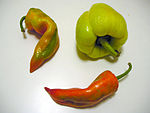Paprika: Difference between revisions
No edit summary |
|||
| Line 4: | Line 4: | ||
'''Paprika''' is a spice made from the grinding of dried sweet red [[bell pepper]]s (''[[Capsicum annuum]]''). In many [[Europe|European]] countries the name ''paprika'' also refers to bell peppers themselves. The seasoning is used in many cuisines to add colour and flavour to dishes. |
'''Paprika''' is a spice made from the grinding of dried sweet red [[bell pepper]]s (''[[Capsicum annuum]]''). In many [[Europe|European]] countries the name ''paprika'' also refers to bell peppers themselves. The seasoning is used in many cuisines to add colour and flavour to dishes. |
||
According to the [[Oxford English Dictionary]], the word comes from the [[Hungarian language|Hungarian]] "paprika", which derives from the [[ |
According to the [[Oxford English Dictionary]], the word comes from the [[Hungarian language|Hungarian]] "paprika", which derives from the [[Croatian language|Croatian]] "paprena", which means "the one that is hot" and it is derived from Croatian noun ''papar'' "pepper" which in turn was borrowed from the Latin "piper", for "pepper." |
||
[[Image:Paprika.fruits.three.j.jpg|left|150px|thumb|Capsicum fruit which comes in various shapes and colours can be used to make paprika.]]<!--I've never heard of paprika made from yellow or green chilis--> |
[[Image:Paprika.fruits.three.j.jpg|left|150px|thumb|Capsicum fruit which comes in various shapes and colours can be used to make paprika.]]<!--I've never heard of paprika made from yellow or green chilis--> |
||
Revision as of 10:21, 14 March 2008

Paprika is a spice made from the grinding of dried sweet red bell peppers (Capsicum annuum). In many European countries the name paprika also refers to bell peppers themselves. The seasoning is used in many cuisines to add colour and flavour to dishes.
According to the Oxford English Dictionary, the word comes from the Hungarian "paprika", which derives from the Croatian "paprena", which means "the one that is hot" and it is derived from Croatian noun papar "pepper" which in turn was borrowed from the Latin "piper", for "pepper."

Paprika is used as an ingredient in a broad variety of dishes throughout the world. Paprika (pimentón in Spain, colorau in Portugal, chiltoma in Nicaragua, but these "paprikas" are not made exclusively from bell peppers, other varieties are used, and there are several hot and sweet "paprikas") is principally used to season and colour rices, stews, and soups, such as goulash. In Spain, Germany, Hungary, Slovakia, Bosnia and Herzegovina, Croatia, Serbia, Romania, Bulgaria, Turkey and Portugal, paprika is also used in the preparation of sausages as an ingredient that is mixed with meats and other spices. Paprika may be smoked for additional flavour.
In India, a similar powdered spice comes from a fruit locally called 'deghi mirchi', which is grown widely and takes on a slightly different flavour depending on local soil and climatic conditions. The hottest paprikas are not the bright red ones, but rather the palest red and light brown coloured ones.
Types of Hungarian paprika (Hungarian name in parentheses):
- Special Quality (Különleges): The mildest and brightest red of all Hungarian paprikas, with excellent aroma.
- Delicate (Édes csemege): Ranging from light to dark red, a mild paprika with a rich flavour.
- Exquisite Delicate (Csemegepaprika): Similar to Delicate, but more pungent.
- Pungent Exquisite Delicate (Csípős Csemege, Pikáns): A yet more pungent Delicate.
- Rose (Rózsa): Pale Red in colour with strong aroma and mild pungency.
- Noble Sweet (Édesnemes): The most commonly exported paprika; bright red and slightly pungent.
- Half-Sweet (Félédes): A blend of mild and pungent paprikas; medium pungency.
- Hot (Erős): Light brown in colour, this is the hottest of all the paprikas.
In Hungarian and some other languages, such as Dutch, German, and Korean, the word "paprika" is used for the fruit, the bell pepper too, of which the spice is made.
Health Benefits
Paprika is unusually high in vitamin C. Hungary's Nobel prize-winning Professor Albert Szent-Györgyi first discovered the vitamin in paprika chile peppers. The capsicum peppers used for paprika contain six to nine times as much vitamin C as tomatoes by weight.
High heat leaches the vitamins from peppers, thus commercially-dried peppers are not as nutritious as those dried naturally in the sun.
As an antibacterial agent and stimulant, paprika can help normalize blood pressure, improve circulation, and increase the production of saliva and stomach acids to aid digestion.[citation needed]
